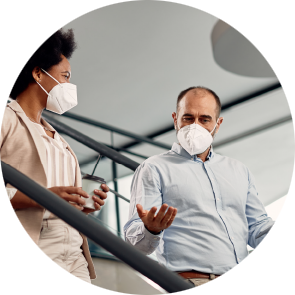COVID-19 response
Working together toward a better “new normal”
Zurich’s COVID-19 response continues

Due to the weeks between this publication’s design and distribution, we can’t say at the time of this writing where the nation and the world will stand in terms of COVID-19 response and recovery by the time you read this. Developments related to this historic pandemic have often evolved rapidly and the recommendations of the scientific and medical communities have evolved in turn to address emergent variants of the virus, vaccination rates that have varied from state to state, documented breakthrough cases among those vaccinated, and other issues.
Most experts agree the virus will be around for years to come and many say it will never be fully eradicated — that it will become an endemic, circulating in different places and at different times forever. That’s not a cause to panic, however, as the widely accepted thinking is that vaccines and acquired immunity among large portions of the population will curb the spread and lessen severity to such a degree that it will become more like the less dangerous, less lethal colds and flus we have long lived with. 1
The phrase “our new normal” started to seep into common use when shut-downs, social distancing and mask protocols were widely put into practice in the spring of 2020. Many adaptive practices also very quickly went from “new” to “normal,” from the astonishing growth of remote working worldwide to inventive small business practices like restaurants constructing streetside “bubbles” to allow outdoor dining in cold weather.
We are still living through this pandemic and as the surge in COVID cases from the Delta variant proved, the road to recovery can be bumpy. But if communities and businesses work together to help overcome emerging challenges, life will eventually get back to more like it was before the pandemic, though likely with far more awareness of conditions that can lead to a viral outbreak, stricter enforcing of hygiene practices, and perhaps with some safety precautions put permanently into practice. Time will tell.
One thing is certain: As far as viruses are concerned, borders really don’t exist. Travel restrictions can help reduce spread in immediate, urgent circumstances, but in a global economy they aren’t a practical, long-term answer.
As the virus evolves, vaccinations likely will too, and as of this writing, it remains to be seen if new “booster” shots or annual vaccinations will be required going forward. But vaccines are clearly leading to significant improvements for society, even allowing for breakthrough cases. This past August, data from the U.S. Centers for Disease Control and Prevention showed that 99.99% of fully vaccinated people have not had a breakthrough case resulting in hospitalizations or death.2
That encouraging statistic may change, just as the vaccines themselves may change, but mass, global vaccination remains the clearest path to reducing the threat of the pandemic.
That’s why this past July, Zurich’s charitable foundation, the Z Zurich Foundation, announced the continuation of its fundraising campaign to help UNICEF's efforts to deliver two billion doses of COVID-19 vaccines globally by the end of 2021. Vaccine distribution inequity has been a serious problem in slowing down the pandemic recovery, which the UNICEF campaign and others seek to correct.
When announcing the continuation of the campaign, Gregory Renand, Head of the Z Zurich Foundation, noted, “There is a global movement to ensure everyone has a chance to be protected from COVID-19, and we applaud everyone who has been supporting it, through our own initiative or others.”
Zurich North America also remains focused on sharing COVID-19 resources, information and insights with businesses, our colleagues and the community at large. New and updated information is published regularly on the coronavirus hub on our Future of Risk page: insights.zurichna.com/coronavirus.
Zurich also continues to review and share established guidance for all businesses to keep in mind if they plan to have workers returning to their offices and facilities.
Internally, we continue to follow the latest guidance from local and national health authorities related to employees working in the office and visitors to our offices. We will adapt practices as needed to ensure the safest environment possible in our facilities.
“Pandemic fatigue” is understandable as we continue well into this second year of COVID-19 precautions, but it’s a weariness we all need to fight ... continuing to do our best to look out for each other and emerge stronger on the other side of this health crisis.

- Phillips, Nicky. “The coronavirus is here to stay — here’s what that means.” Nature. 16 February 2021. https://www.nature.com/articles/d41586-021-00396-2
- McPhillips, Deidre and Christina Maxouris. “About 99.999% of fully vaccinated Americans have not had a deadly Covid-19 breakthrough case, CDC data shows.” CNN. 2 August 2021. https://www.cnn.com/2021/07/31/ health/fully-vaccinated-people-breakthrough-hospitalization-death/index.html
_____________
5 PROGRAM LEADER